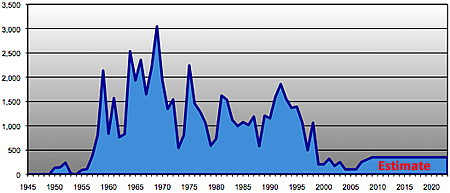Nuclear Weapons Stockpile Secrecy And Confusion
 |
| Sorry, can’t tell! The size of the nuclear weapons stockpile is secret, but not hard to figure out. |
.
By Hans M. Kristensen
In a letter to the editor in Boston Globe, Thomas D’Agostino, the administrator of the National Nuclear Security Administration (NNSA), writes that the United States is reducing its nuclear weapons and that, “Currently, the stockpile is the smallest it has been since the Eisenhower administration.”
That statement leaves considerable confusion about the size of the stockpile. If “since the Eisenhower administration” means counting from 1961 when the Kennedy administration took over, that would mean the stockpile today contains nearly 20,000 warheads. If it means counting from the day the Eisenhower administration took office in 1953, it would mean fewer than 1,500 warheads.
Why leave an order of magnitude of confusion about the size of the nuclear weapons stockpile?
Stockpile History
Neither number is correct. The actual stockpile size today, based on what I and my colleagues at NRDC can piece together, is approximately 5,300 warheads, or roughly the size of the stockpile in 1957 (see Figure 1). That is certainly a lot less than the 1980s, but it’s also an awful lot for the 21st century.
|
Figure 1: |
 |
| The size of the U.S. nuclear weapons stockpile has declined ever since the mid-1960s, and currently includes roughly 5,300 warheads, or approximately the size of the stockpile in 1957. When all announced reductions have been implemented in 2012, the size of the stockpile will have returned to the 1956-level of approximately 4,600 warheads. |
.
Mr. D’Agostino is, of course, in a bind because even though he and others at NNSA might agree that the stockpile size could be declassified, the Department of Defense insists it has to be kept secret. Even disclosing the number of nuclear weapons dismantled each year is prohibited, because it could help reveal the size of the nuclear stockpile. As it turns out, warhead dismantlement during the Bush administration has been the lowest since 1956 (see Figure 2).
|
Figure 2: |
 |
| Even with the recent announcement of an “astounding 146 percent increase” in warhead dismantlement in 2007 and another 20 percent in 2008, the Bush administration’s dismantlement rate remains the lowest of any administration since 1956. |
.
What motivates this secrecy, other than the usual resistance to transparency in nuclear weapons matters, is preparation for a world of smaller nuclear arsenals a decade or two from now, when the United States might have reduced the number of deployed nuclear weapons to perhaps 1,000 or even less. In such a world, some fear, Russia or China might suddenly turn for the worse and secretly increase their nuclear arsenals and change the strategic balance. Knowing how many nuclear weapons the United States holds in reserve to increase the deployed force could, so the argument goes, greatly affect the U.S. ability to act and protect its allies. It’s kind of like reverse psychology: With fewer nuclear weapons it matters more what adversaries know.
A Policy For The Future
Keeping the size of the stockpile secret might have been a valid national security requirement during the Cold War, even though I don’t find the arguments very convincing. But today, nearly two decades after the Cold War ended, it is fair to ask: So what if potential adversaries know how many nuclear weapons the United States has?
If my colleagues and I can make a fairly accurate estimate, so can Russia and China. How can anyone in this day and age seriously argue that it matters that they’re 10-100 warheads off? And isn’t it better that they and our allies know the truth, instead of making their own assumptions?
More importantly, however, is that the stockpile and dismantlement numbers today are very effective instruments for showing the world that the United States is not building up its nuclear arsenal. They reassure allies and deprive adversarial hardliners the uncertainty they need to argue for nuclear modernization. Stockpile transparency, not worst-case breakout and warfighting theories, combined with an aggressive and sustained foreign policy effort to engage other nuclear weapon states, should be the priority for the next administration.
Background Information: Status of World Nuclear Forces 2008 | US Nuclear Force 2008 | Russian Nuclear Forces 2008 | Chinese Nuclear Forces 2008
This report outlines a framework relying on “Cooperative Technical Means” for effective arms control verification based on remote sensing, avoiding on-site inspections but maintaining a level of transparency that allows for immediate detection of changes in nuclear posture or a significant build-up above agreed limits.
The grant comes from the Carnegie Corporation of New York (CCNY) to investigate, alongside The British American Security Information Council (BASIC), the associated impact on nuclear stability.
Satellite imagery of RAF Lakenheath reveals new construction of a security perimeter around ten protective aircraft shelters in the designated nuclear area, the latest measure in a series of upgrades as the base prepares for the ability to store U.S. nuclear weapons.
It will take consistent leadership and action to navigate the complex dangers in the region and to avoid what many analysts considered to be an increasingly possible outcome, a nuclear conflict in East Asia.